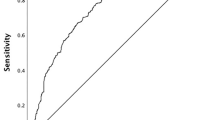Abstract
Background
Although exogenous follicle-stimulating hormone (FSH) has been used for decades and millions of cycles have been performed worldwide until now, criteria for selecting the proper FSH starting dose have not been clearly identified. The aim of this study was to elaborate a formula based on markers of ovarian reserve for the calculation of the appropriate starting dose of FSH.
Methods
A total of 931 patients underwent in vitro fertilization (IVF) treatment using long GnRH agonist protocol was retrospectively identified and reviewed. 673 cases of them with a normal ovarian response (4–14 retrieved oocytes) were used to analysis the predictive formula. All follicles 4–7 mm in diameter were counted in the same day of blood sample in both ovaries using transvaginal ultrasound scan. The modified protocol of each patient was recorded and analyzed in the same center. In another center were the numbers of retrieved oocytes of 750 validated patients recorded and analyzed.
Results
A formula model based on age, AMH, and antral follicle count (AFC) was able to accurately predict the ovarian sensitivity and accounted for 57.2% of the variability of ovarian response to FSH. When tested in the same total population used to elaborate the model it predicts a high 46.88% rate of step-down protocol in higher-starting FSH dose group and about 57.92% of patients had their dose step-up modified in lower-starting FSH dose group during their treatment, respectively. And when tested in different population from another center used to elaborate the model it predicts a high 64.40% rate of ≥ 15 retrieved oocytes in higher-starting FSH dose group and about 22.50% of patients had ≤ 7 retrieved oocytes in lower-starting FSH dose group during their treatment, respectively.
Conclusions
In the present study we demonstrated that the individualized FSH starting dose may be calculated on the basis of a woman’s age, AMH and AFC. The formula model might be a useful, immediate, and easily applicable tool for clinicians to predict the tailored starting dose of FSH during their daily clinical practice.
Similar content being viewed by others
References
Macklon NS, Stouffer RL, Giudice LC et al (2006) The science behind 25 years of ovarian stimulation for in vitro fertilization. Endocr Rev 27(2):170–207. https://doi.org/10.1210/er.2005-0015
Ji J, Liu Y, Tong XH et al (2013) The optimum number of oocytes in IVF treatment: an analysis of 2455 cycles in China. Hum Reprod 28(10):2728–2734. https://doi.org/10.1093/humrep/det303
Allegra A, Marino A, Volpes A et al (2017) A randomized controlled trial investigating the use of a predictive nomogram for the selection of the FSH starting dose in IVF/ICSI cycles. Reprod Biomed Online 34(4):429–438. https://doi.org/10.1016/j.rbmo.2017.01.012
Howles CM, Saunders H, Alam V et al (2006) Predictive factors and a corresponding treatment algorithm for controlled ovarian stimulation in patients treated with recombinant human follicle stimulating hormone (follitropin alfa) during assisted reproduction technology (ART) procedures. An analysis 1378 patients. Curr Med Res Opin 22(5):907–918. https://doi.org/10.1185/030079906X104678
Fauser BCJM, Diedrich K, Devroey P (2008) Predictors of ovarian response: progress towards individualized treatment in ovulation induction and ovarian stimulation. Hum Reprod Update 14(1):1–14. https://doi.org/10.1093/humupd/dmm034
La MA, Sunkara SK (2014) Individualization of controlled ovarian stimulation in IVF using ovarian reserve markers: from theory to practice. Hum Reprod Update 20(1):124–140. https://doi.org/10.1093/humupd/dmt037
Moolenaar LM, Broekmans FJ, Van DJ et al (2011) Cost effectiveness of ovarian reserve testing in in vitro fertilization: a Markov decision-analytic model. Fertil Steril 96(4):889–894. https://doi.org/10.1016/j.fertnstert.2011.06.072
Fleming R, Broekmans F, Calhaz-Jorge C et al (2013) Can anti-Mullerian hormone concentrations be used to determine gonadotrophin dose and treatment protocol for ovarian stimulation? Reprod Biomed Online 26(5):431–439. https://doi.org/10.1016/j.rbmo.2012.02.027
La MA, Sighinolfi G, Radi D et al (2010) Anti-Mullerian hormone (AMH) as a predictive marker in assisted reproductive technology (ART). Hum Reprod Update 16(2):113–130. https://doi.org/10.1093/humupd/dmp036
Lan VT, Linh NK, Tuong HM et al (2013) Anti-Müllerian hormone versus antral follicle count for defining the starting dose of FSH. Reprod Biomed Online 27(4):390–399. https://doi.org/10.1016/j.rbmo.2013.07.008
Al-Azemi M, Killick SR, Duffy S et al (2011) Multi-marker assessment of ovarian reserve predicts oocyte yield after ovulation induction. Hum Reprod. 26(2):414–422. https://doi.org/10.1093/humrep/deq339
Broekmans FJ, Kwee J, Hendriks DJ et al (2006) A systematic review of tests predicting ovarian reserve and IVF outcome. Hum Reprod Update 12(6):685–718. https://doi.org/10.1093/humupd/dml034
Broekmans FJM, Ziegler DD, Howles CM et al (2010) The antral follicle count: practical recommendations for better standardization. Fertil Steril 94(3):1044–1051. https://doi.org/10.1016/j.fertnstert.2009.04.040
Fleming R, Seifer DB, Frattarelli JL et al (2015) Assessing ovarian response: antral follicle count versus anti-Mullerian hormone. Reprod Biomed Online 31(4):486–496. https://doi.org/10.1016/j.rbmo.2015.06.015
Iliodromiti S, Anderson RA, Nelson SM (2015) Technical and performance characteristics of anti-Mullerian hormone and antral follicle count as biomarkers of ovarian response. Hum Reprod Update 21(6):698–710. https://doi.org/10.1093/humupd/dmu06
Iliodromiti S, Nelson SM (2015) Ovarian response biomarkers: physiology and performance. Curr Opin Obstet Gynecol 27(3):182–186. https://doi.org/10.1097/GCO.0000000000000175
Carvalho BRD, Silva JCRE, Reis RMD et al (2008) Ovarian reserve evaluation: state of the art. J Assist Reprod Genet 25(7):311–322. https://doi.org/10.1007/s10815-008-9241-2
Broer SL, Mol BW, Hendriks D et al (2009) The role of antimullerian hormone in prediction of outcome after IVF: comparison with the antral follicle count. Fertil Steril 91(3):705–714. https://doi.org/10.1016/j.fertnstert.2007.12.013
Broer SL, Dólleman M, Opmeer BC et al (1900) AMH and AFC as predictors of excessive response in controlled ovarian hyperstimulation: a meta-analysis. Hum Reprod Update 17(1):46–54. https://doi.org/10.1093/humupd/dmq034
Lenton EA, Sexton L, Lee S et al (1988) Progressive changes in LH and FSH and LH: FSH ratio in women throughout reproductive life. Maturitas 10(1):35–43
Todorovic BP, Loft A, Bredkjæer HE et al (2003) A prospective randomized clinical trial comparing an individual dose of recombinant FSH based on predictive factors versus a ‘standard’ dose of 150 IU/day in ‘standard’ patients undergoing IVF/ICSI treatment. Hum Reprod 18(11):2275–2282
Todorovic BP, Loft A, Lindhard A et al (2003) A prospective study of predictive factors of ovarian response in ‘standard’ IVF/ICSI patients treated with recombinant FSH. A suggestion for a recombinant FSH dosage normogram. Hum Reprod 18(4):781–787
Popovic Todorovic B, Loft A, Ziebe S et al (2004) Impact of recombinant FSH dose adjustments on ovarian response in the second treatment cycle with IVF or ICSI in “standard” patients treated with 150 IU/day during the first cycle. Acta Obstet Gynecol Scand 83(9):842–849. https://doi.org/10.1111/j.0001-6349.2004.00573.x
Andersen AN, Devroey P, Arce JC (2006) Clinical outcome following stimulation with highly purified hMG or recombinant FSH in patients undergoing IVF: a randomized assessor-blind controlled trial. Hum Reprod 21(12):3217–3227. https://doi.org/10.1093/humrep/del284
Devroey P, Polyzos NP, Blockeel C (2011) An OHSS-free clinic by segmentation of IVF treatment. Hum Reprod 26(10):2593–2597. https://doi.org/10.1093/humrep/der251
Lainas TG, Sfontouris IA, Zorzovilis IZ, Petsas GK et al (2010) Flexible GnRH antagonist protocol versus GnRH agonist long protocol in patients with polycystic ovary syndrome treated for IVF: a prospective randomised controlled trial (RCT). Hum Reprod 25(3):683–689. https://doi.org/10.1093/humrep/dep436
Marca AL, Papaleo E, Grisendi V et al (2012) Development of a nomogram based on markers of ovarian reserve for the individualisation of the follicle-stimulating hormone starting dose in in vitro fertilisation cycles. BJOG 119(10):1171–1179. https://doi.org/10.1111/j.1471-0528.2012.03412.x
Karlsson MO, Wade JR, Loumaye E et al (1997) A population model for the follicular growth in women treated with follicle stimulating hormone. Clin Pharmacol Ther 62(6):665–674. https://doi.org/10.1016/S0009-9236(97)90086-2
Abdalla HI, Burton G, Kirkland A et al (1993) Age, pregnancy and miscarriage: uterine versus ovarian factors. Hum Reprod 8(9):1512–1517
Olivennes F, Howies CM, Borini A et al (2011) Individualizing FSH dose for assisted reproduction using a novel algorithm: the CONSORT study. Reprod Biomed Online 22(Suppl 1):S73–82. https://doi.org/10.1016/S1472-6483(11)60012-6
Arce JC, Andersen AN, Fernández-Sánchez M, Visnova H, Bosch E, García-Velasco JA et al (2014) Ovarian response to recombinant human follicle-stimulating hormone: a randomized, antimüllerian hormone-stratified, dose-response trial in women undergoing in vitro fertilization/intracytoplasmic sperm injection. Fertil Steril 102(6):1633–1640.e5. https://doi.org/10.1016/j.fertnstert.2014.08.013
Bosch E, Nyboe AA, Barri P et al (2015) Follicular and endocrine dose responses according to anti-Müllerian hormone levels in IVF patients treated with a novel human recombinant FSH (FE 999049). Clin Endocrinol (Oxf) 83(6):902–912. https://doi.org/10.1111/cen.12864
Funding
This study was supported by Chinese National Natural Science Foundation (81771537, 81571504, 81200450), Nanjing Medical Science and technique Development Foundation (QRX11166), Maternal and fetus medicine Key Lab of Jiangsu Province (XK 201102, BL2014003).
Author information
Authors and Affiliations
Contributions
HS protocol/project development. JZ protocol/project development, manuscript correction and revision. MZ protocol/project development, data collection and management, manuscript writing and editing, data analysis. SW data collection and management, manuscript editing, data analysis. SY data collection and management. XH data collection and management. JNM: data collection and management. LC validated data collection and management.
Corresponding authors
Ethics declarations
Conflict of interest
The authors declare that they have no conflict of interest.
Additional information
Publisher's Note
Springer Nature remains neutral with regard to jurisdictional claims in published maps and institutional affiliations.
Haixiang Sun and Jianjun Zhou should be regarded as co-corresponding authors.
Rights and permissions
About this article
Cite this article
Zhu, M., Wang, S., Yi, S. et al. A predictive formula for selecting individual FSH starting dose based on ovarian reserve markers in IVF/ICSI cycles. Arch Gynecol Obstet 300, 441–446 (2019). https://doi.org/10.1007/s00404-019-05156-2
Received:
Accepted:
Published:
Issue Date:
DOI: https://doi.org/10.1007/s00404-019-05156-2




